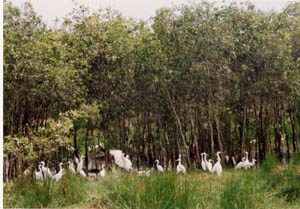A series of cajuput forests in Long An, Dong Thap, and Tien Giang have been cut down by farmers, who are transitioning to rice and other crops. The destruction of cajuput forests poses a threat to the wetland ecosystem, creating openings for saltwater intrusion…
 |
Cajuput Forest Reserve |
What impact will the diminishing cajuput forests have on the ecological environment? Is the decline in cajuput prices truly due to oversupply, or is it merely a seasonal market crisis? The current situation of cajuput once again highlights the need for planning, the connection between production and market must be based on scientific arguments, grounded in reality, with a long-term vision and synchronized solutions…
In Long An alone, farmers have “erased” about 1,000 hectares of cajuput in just one year… Why is cajuput—once considered a key crop in the Dong Thap Muoi region, alongside rice—now facing the risk of diminishing areas(!?).
Returning to Rice Cultivation
Mrs. Pham Thi Mau, from Truong Xuan Commune (Thap Muoi District, Dong Thap), has 1.5 hectares of three-year-old cajuput but still decided to cut it down to plant rice. She said, “Cutting cajuput now means calling the children to take it home for firewood; the loss is more than ten million VND.” In Truong Xuan Commune, nearly ten hectares of cajuput have recently been cut down in preparation for the upcoming winter-spring rice season.
According to the Chairman of Truong Xuan Commune, Ngo Van Nghia, the area will be planned to improve the internal irrigation system and create closed dikes to convert all cajuput areas into land for the third rice crop. In the region specializing in pineapple cultivation, farmers in Tan Phuoc District (Tien Giang) are not returning to rice, but are also cutting cajuput to plant pineapples.
In Long An—the locality with the largest area of cajuput forest in the Mekong Delta—the situation of farmers cutting cajuput is even more rampant. According to Vo Quan Huy, who owns a 100-hectare cajuput farm, self-destructing cajuput is both labor-intensive and costly. Thus, many cajuput growers abandon the land when 1-2 year old cajuput is burned. In just five years, the area of cajuput forest in Long An has continuously decreased: from 90,000 hectares in 2000 to about 68,000 hectares now.
Cutting Due to Falling Prices
The Dong Thap Muoi region once had many farmers who became wealthy from cajuput. Mr. Nguyen Van Truong, from Tuyen Binh Commune (Vinh Hung District, Long An), built a house worth nearly 500 million VND thanks to his five hectares of cajuput. Many households in the Dong Thap Muoi area have supported their children’s education and built homes through cajuput cultivation.
However, Mr. Tran Buu Xe, from Thap Muoi District (Dong Thap), who just cut down one hectare of cajuput, stated: “High-quality cajuput used to sell for 15,000 VND, now the price has dropped to half. It takes six years to harvest cajuput, while this land can produce three rice crops in one year. Growing rice is more profitable.” Additionally, Mr. Tu Hai from Tan Phuoc District (Tien Giang) mentioned that the price of cajuput has never dropped as it has now, from 70 to nearly 100 million VND per hectare, now reduced by more than half. Pineapple cultivation yields higher profits.
Master Le Phat Quoi (Head of the Science Department, Long An Department of Science and Technology) noted: Many patches of 4-5 year old cajuput have been completely cut down and piled up. Some opinions suggest that Long An farmers should integrate fish farming within cajuput forests to increase income. However, due to the high acidity, cajuput growers in Long An find it hard to raise fish, as they would die from eye popping.
In Tien Giang, the planned area for forest cultivation was about 13,200 hectares (in 2006), with cajuput as the main crop. However, given the current situation of cajuput cutting, maintaining nearly 9,000 hectares of existing cajuput is already a challenging task.
The majority of the cajuput area that has been cut down was previously rice-growing land. There is an opinion that after a period of cajuput cultivation, returning to rice would yield higher effectiveness as the soil would have accumulated nutrients. Given the supply-demand dilemma in the market, it is unreasonable to force cajuput growers to keep their cajuput and not return to rice farming.
Don’t Rush to Cut!
In about 4 to 7 years, the demand for wood in the world market will peak. Currently, China has temporarily halted timber exports to ensure domestic demand. As soon as we provided some information about cajuput areas in the Mekong Delta, two Taiwanese companies immediately expressed interest in exploring purchasing options.
From March to September 2005, I, along with some Japanese experts, conducted surveys on cajuput raw material regions in the Mekong Delta and at several wood and paper processing enterprises. The results showed that 90% of businesses in Ho Chi Minh City had to import wood; many paper mills lacked raw materials…
Subsequently, about 2 tons of cajuput of various ages grown in the Mekong Delta were sent to Japan. These activities were part of a cooperative trial between Can Tho University and the Japan International Cooperation Agency.
We are advocating for the government to approve the construction of a feasible project for a cajuput wood processing plant, capable of consuming raw materials from 40,000 hectares of cajuput per year in the Mekong Delta. If approved, Japan will support all funding (approximately 138 million USD).
These are the reasons I advise farmers to keep their cajuput.
Dr. Duong Van Ni (Director of the Hoa An Biodiversity Experimental Research Center, Can Tho University)
What to Do to Preserve the Forest?
The fact that farmers are cutting down cajuput raises concerns. This is because cajuput cultivation not only considers economic efficiency but also contributes significantly to environmental and landscape issues. While cajuput prices are falling, this does not necessarily mean oversupply. Without any research on the cajuput market, how can we draw conclusions?
At present, while cajuput prices have dropped, compared to the volatility of other agricultural products, cajuput may not be faring worse. Therefore, during this difficult time, the agricultural and forestry sectors in localities with cajuput cultivation areas need to strengthen support for farmers to change their farming practices and promote intercropping to increase efficiency on the same land area.
It is quite unfair that shrimp farming, which has caused localized environmental pollution in many areas, receives preferential loans, while cajuput cultivation, which creates a good ecosystem, does not receive significant financial support…
Dr. Mai Van Nam (Head of the Economics and Management Department, Can Tho University)
Significant Environmental Damage
Administrative intervention cannot be used regarding farmers cutting down cajuput trees. The price of cajuput has continuously decreased, from 80 million VND per hectare to 30 million VND. It takes five years for cajuput to become profitable; during that time, how do cajuput farmers survive? Moreover, if there is a fire, they lose everything. In contrast, rice currently averages a profit of 10 million VND per hectare per year.
However, it is worth noting that currently, the forest coverage in the Mekong Delta is only about 10%, which is low compared to the requirement of 30%. Deforestation, including cajuput, causes significant environmental damage such as failure to retain freshwater and saltwater intrusion… Planning for the “lungs” of the Mekong Delta is essential. Therefore, we must consider how to maintain the area of cajuput. To achieve this, specific policies for cajuput growers must be developed…
Dr. Mai Thanh Phung (Southern Branch of the National Agricultural Extension Center)




















































